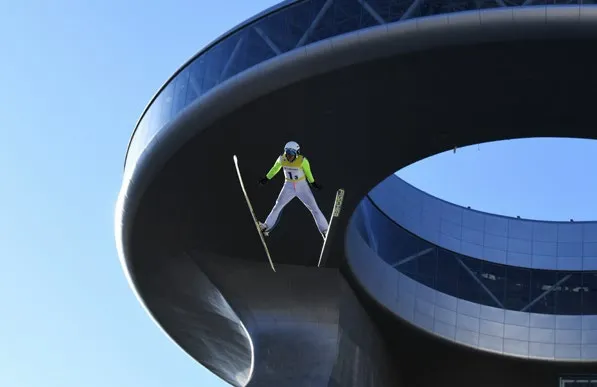PERMANENT FIXTURES
2022-02-21ByTaoZihui
By Tao Zihui

Zhang Li
Interview with Zhang Li, the venue designer for the 2022 Beijing Winter Olympics
with the 2022 Beijing Winter Olympic Games just around the corner, some of the competition venues for the event are already popular tourist attractions.During preparations for the 2022 Winter Games, sustainable use of the legacy of the 2008 Beijing Olympic Games has been realized.For example, the National Aquatics Center, also known as the Water Cube, has been transformed into an“Ice Cube” for curling events with the help of advanced technology.Meanwhile, a number of new venues with distinctive features have also been built such as the Zhangjiakoubased National Ski Jumping Center,nicknamed “Snow Ruyi” thanks to its shape resembling that of a ruyi, a traditional Chinese scepter symbolizing good luck, Beijingbased Big Air Shougang, with a design inspired by the image of flying apsaras seen in the Mogao Caves in Gansu Province, and the National Speed Skating Oval, dubbed the “Ice Ribbon”for its exterior design resembling 22 floating ribbons.
How do these newly constructed venues for the Winter Olympics demonstrate Oriental aesthetic and cultural values and help present China to the world? Zhang Li, dean of the School of Architecture of Tsinghua University and chief designer of Big Air Shougang and sports facilities located in the Zhangjiakou competition zone, sat down with China Report ASEAN to share his thoughts on the topic.
Q: How can the Winter Olympic venues serve both the athletes and the public?
Zhang Li:Over the past decadeplus, I have participated in the design of several landmark structures in China such as the China Pavilion at the 2010 Shanghai World Expo,the Beijing venue for the Seventh National Flower Show of China, and the post-quake reconstruction of Yushu in Qinghai Province.I believe that construction of an event-type public facility has the power to promote urban renewal.Rather than serving just the event itself, it should also have a long-term influence.
Venues for the Olympic Games,especially ski events, are built for professional athletes.If these structures are to serve regular people for long after the events, they must be adapted for daily use.To ensure the new competition venues for the 2022 Winter Games can provide longterm services, our designs integrated functionality for general public activities into the highly specialized sports facilities.
The top of the “Snow Ruyi,” for example, offers a panorama of the surrounding mountains while equipped with a 4,000-square-meter multifunctional assembly hall for performances and conferences.At the same time, the outdoor stadium at the bottom of the ramp provides a flat open space for activities like mini soccer games, product launches,concerts, and other types of activities.
Q: How did your design minimize the impact of venue construction on the ecological environment?
Zhang Li:We worked out a sensible compromise.So-called “minimum intervention” is often interpreted as “building as little as you can.” In the case of the Snow Ruyi, minimal construction would mean building a permanent track directly on a mountain slope, which would consequently block animal migration across both sides of the mountain or other forms of movement in nature.So in our design, the ramp for ski jumping and the pedestrian bridge called the “Ice Jade Ring” are elevated above the ground.This increased the volume of construction, but the surface runoff,nutrient access, and animal movement can all continue uninterrupted.

An athlete trains at the National Ski Jumping Center in the Zhangjiakou competition zone of the 2022 Beijing Winter Olympics on February 25, 2021.(VCG)
Q: How are you presenting China to the world through the design of Olympic venues?
Zhang Li:I think there are three basic elements.First, we need to focus on matters of common concern.For example, people are now interested in issues such as keeping healthy, the lives of ordinary people,comprehensive development of a fairer society, and climate change as well.Any man-made structure may need to respond to issues like how to improve human health, promote social equality, and contribute to carbon neutrality.
Second, we need to tell the stories of China through open communication with others.China has gained considerable experience in sports venue design and construction,but I’m not sure whether our experience could be of help to other countries.We are glad to exchange ideas with our peers.
Third, we must focus on everything that has been achieved in our unique cultural and social environment.Preparations for the 2022 Winter Olympics have created more jobs and helped local villagers escape poverty.Work on infrastructure started long before construction of winter sports facilities thanks to the efforts of regional development planners and builders, not architects.
Q: How do your personal experiences influence your architectural design?
Zhang Li:A lot of people I have met have had a great influence on me.In the 1990s, many architects were obsessed with establishing personal style through buildings with weird shapes, while my doctoral supervisor Guan Zhaoye at Tsinghua University advocated architecture that was more modest than luxurious or novel.I think in the process of changing the landscape of our planet, architectural designers should work humbly and with awe and respect.
When I was a visiting scholar at Harvard University, I met with Professor Joan Busquets, the master planner for the 1992 Barcelona Olympics.He described to me howhe had helped transform the city in its run-up to the Olympic Games and taught me how to read the urban space.That meeting gave me new perspectives on interpreting the history of a city and the people living in it.
I grew up in a typical Beijing residential compound.My most enduring childhood memories in the 1970s involve everyone in the community knowing each other well and interacting with neighbors like members of a big family.A particularly touching moment happened when a flock of pigeons flew over the residential compound in the fall.The sunny sky and the smell of the soil accompanied sounds of pigeon calls and leaves of persimmon trees rustling softly in the wind,creating emotional memories for everyone living in the community.Such experience in a public space has always intrigued me as an architectural designer.
